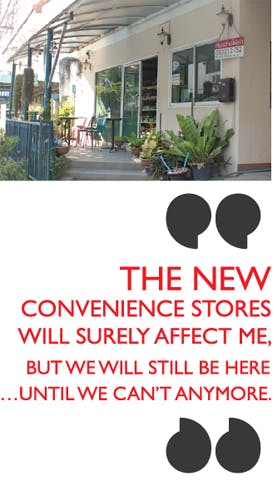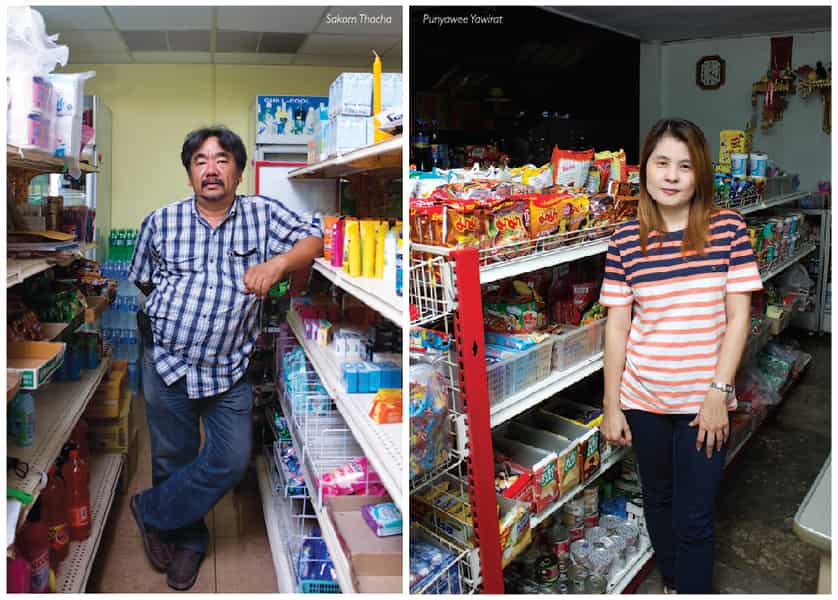Another day, another eight million people step through 7-Eleven’s automatic sliding doors to a colourful assortment of snacks and items temptingly arranged on white shelves. A toastie? A chopped up hot dog? A packet of lobster hot plate flavoured potato chips? The choices are endless.
In 2014, Thailand opened its 8,000th 7-Eleven branch, officially surpassing the United States for most 7-Eleven branches despite being a country the size of Texas with a population approximately one fifth the size of the United States. Think about that for a second. Thailand now holds the number two spot in the world for biggest global market for 7-Elevens, second only to Japan.
“Thailand is a large and attractive emerging market,” says Dr. Randall Shannon, a Marketing Ph.D. at Mahidol University in Bangkok.
The outbreak shows no signs of stopping, either. CP All, 7-Eleven Thailand’s sole operating company, has announced plans to expand its business to over 10,000 stores by 2018, which puts traditional trade shops such as fresh markets and mom and pop shops at serious risk.
“7-Eleven is a far bigger threat to the traditional trade shops than supermarkets or hypermarkets,” wrote Dr. Shannon in an academic overview of Thailand’s food retailing transformation over recent years.
Convenience store titans like 7-Eleven, Tesco Lotus Express and Mini Big C sell everything a customer could ever need, from ready-to-eat meals, beverages, and snacks to cigarettes, alcohol, and toiletries to utility and phone bill payment services. Soon, you might even be able to do your immigration check-ins here, according to Chiang Mai’s immigration chief. Their stores are well-lit and air-conditioned 24 hours a day, seven days a week. Furthermore, they’re located on virtually every major street corner in Thailand – sometimes even across the street from one another.
“I go to 7-Eleven every day,” says Peea Arrin, a 20-year-old Chiang Mai University student. “I can buy anything I want from one place.” She carries a bag of chips in her hand that she bought them from 7-Eleven this morning.
Peea is one of many local Thais that contribute to long lines at convenience stores on a daily basis –sometimes making multiple trips to the same store in a single day to purchase snacks and beverages, top up her cellphone, or simply to find relief from scorching summer heat inside the air-conditioned stores.
The accessibility of these stores is what makes them so appealing for Thais. It’s about convenience.

“Street food vendors are open mainly in the evening,” says Aim Cheraim, another student at CMU. “If I want a quick breakfast, I go to 7-Eleven.”
With every new generation of Thais, Thailand becomes more and more familiar with modern food retailing markets. For the past 25 years, Thailand’s markets have been evolving rapidly, with negative outcomes for the more traditional, independent retailers.
“Business hasn’t been going too well after the 7-Eleven opened up down the street a few years ago,” says Sakorn Thacha, co-owner of a Chiang Mai mom and pop shop near the university.
Sakorn, a 56-year-old father of two grown children, speaks with a gentle demeanor punctuated every now and then with a spontaneous chuckle. His store, named “M and M” after his two children May and Mong, belongs to his wife, and opened a decade ago when the married couple realised there weren’t any food markets close by. Their store rests in the middle of a small road a few metres away from a relatively new 7-Eleven that’s located on the corner of the main road. Unfortunately for Sakorn, to get to M and M, customers have to drive past 7-Eleven first.
Same goes for Punyawee Yawirat, a 38-year-old woman with long hair and a youthful complexion that belies the wisdom she’s gained from living in the city all these years. Her store is between two 7-Elevens, located on both ends of her street.
“Ever since the 7-Eleven opened up by the dormitory, all the customers from that area have been going there,” she tells me with a sigh.
The cold, hard fact is that mom and pop shops don’t offer any products or services that aren’t offered at 7-Eleven and other convenience stores. So, they have to focus on their strengths, such as more personable service, to compete.
During our interview at M and M, a young man stepped into Sakorn’s store and chatted with him a while. He then handed him 20 baht for a snack he had bought the day before and went on his way. I.O.U’s aren’t uncommon for mom and pop shops. These places thrive on good relationships with regulars – something that massive companies like 7-Eleven could never hope to achieve. Punyawee’s shop is a bustling hang-out spot in the evening. The tables and chairs out front are usually filled with jovial locals drinking and laughing late into the night. 7-Elevens, meanwhile, while often used as meeting points, are not designed for spending long periods of time.
“Anyone is welcome to sit here if they want,” says Punyawee of her store. “Whether they buy something or not depends on them.”
Other stores employ more practical tactics to survive, such as selling single cigarettes, making alcohol available for purchase during extended hours, or simply selling some of their most popular products for a couple baht cheaper than 7-Eleven. And despite the growing familiarity between Thai consumers and modern food retailers, Thais still show a strong preference for more traditional styles.

“All Thais prefer to go to the fresh market for food, it’s fresh and delicious,” says Arrin. But, she reiterates, “food at 7-Eleven is more convenient.” And that’s the sticking point.
As Thailand quickly shifts to a more hurried lifestyle, the convenience of 24-hour, ready-to-eat meals, and accessibility of these one-stop-shops will continue to become more appealing to Thai consumers. It’s a sign that Thai consumers are changing.
“As opposed to most western shoppers, Thai shoppers tend to have a relatively low time pressure,” says Dr. Shannon. “This value was found to be decreasing among younger Thais. Question remains as to how well the traditional trade can survive.”
Traditional food retailers in Thailand, however, don’t seem to be too concerned about the future of their stores. Ask any Thai convenience store owner what they think about the future, they’ll tell you the same sort of thing.
“The new convenience stores will surely affect me, but we will still be here…until we can’t anymore,” says Sakorn.
If the success of modern food retailers has taught us anything, it’s that store owners like Sakorn and Punyawee may be part of a dying breed. There’s no question Thailand is undergoing a massive change in its marketplace that’s influenced Thai social behaviour. The question is: how? Whatever the answer, it’s clear that Thailand’s way of life will never be the same again.
Meanwhile, Sakorn and his family have been in the convenience store business for ten years. In that time, they’ve seen businesses come and go. Sakorn’s soft-spoken, laid-back demeanor represents a very traditionally Thai way of doing things – a stark contrast to the busy lifestyle of the West. While he and his fellow mom and pop shop owners are well aware of the impending threat that convenience store giants represent, they find there’s no use in thinking about that now. Mai pen rai.

